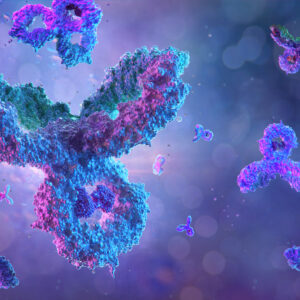Escherichia coli
E. coli is a bacterial species that normally resides in the intestines of people and animals. However, some types of E. coli, particularly E. coliO157:H7, can cause intestinal infection. E. coli O157:H7 and other strains that cause intestinal sickness are called Shiga toxin–producing E. coli (STEC) after the toxin they produce.
Symptoms of intestinal infection include diarrhoea, abdominal pain, and fever. More severe cases can lead to bloody diarrhoea, dehydration, or even kidney failure. People with weakened immune systems, pregnant women, young children, and older adults are at increased risk for developing these complications.
To support research into E. coli infection, The Native Antigen Company has developed an E. coli monoclonal and polyclonal antibodies that are highly specific to the O157:H7 strain, as well as polyclonal antibodies for a variety of other strains.
E. coli Background
E. coli is a gram-negative, rod-shaped, facultative, anaerobic bacterium. Most strains of E. coliare harmless, but some are pathogenic to humans. Some of these pathogenic strains of E. coliproduce Shiga toxins – potent bacteriophage encoded cytotoxins. Shiga toxin-producing E. coli (STEC) are a common causes of severe food poisoning in humans worldwide.
Cattle and other ruminants are natural reservoirs of E. coli O157:H7, where the bacteria exists in the animals’ intestine as part of its normal intestinal flora. Outside of the natural host, E. coli O157:H7 can survive in diverse environments including water, soil and food. In particular, E. coli O157:H7 can survive in meat that has been contaminated with faecal matter and undercooked beef. E. coli O157:H7 bacteria can thrive at temperatures ranging from 7 – 50oC, so that thorough cooking of meats is essential to destroy it. Other foods have been linked to E. coli O157:H7 outbreaks including unpasteurised milk, cured meats, bean sprouts and leafy vegetables, which have all been associated with faecal contamination.
E. coli O157 can infect individuals from all age groups, is resistant to stomach acids and is highly infectious. In humans, the ingested bacterium invades and colonises the intestinal mucosa. Symptoms of E. coli O157 infection include stomach cramps, haemorrhagic diarrhoea and vomiting. Haemolytic uremic syndrome (HUS) may also occur in severe cases of infection, which can result in life threatening renal failure.
Pathogenic strains of E. coli acquire virulence factors through various means including plasmids and bacteriophages. Several virulence factors are associated with E. coli O157:H7, including Shiga toxins, putative virulence plasmid O157 (pO157) and a pathogenicity island referred to as the locus of enterocyte effacement (LEE). Together, these virulence factors are currently thought to be responsible for the pathogenic nature of E. coli O157:H7 (Lim JY).
References
- Lim JY, Yoon J, Hovde CJ. 2010.A brief overview of Escherichia coli O157:H7 and its plasmid O157. J Microbiol Biotechnol. Jan;20(1):5-14
E. coli Antigens
The Native Antigen Company is pleased to offer a native E. coli antigen from its matched antigen and antibody BacTrace range.
No Results Found
The page you requested could not be found. Try refining your search, or use the navigation above to locate the post.
E. coli Antibodies
The Native Antigen Company offers a high-specificity monoclonal antibody to the Escherichia coli O157:H7 strain. Our E. coli antibody has been extensively tested to show that it does not cross-react with a wide range of other, related E. coli strains or bacteria responsible for gastrointestinal infections.
Questions?
Check out our FAQ section for answers to the most frequently asked questions about our website and company.

